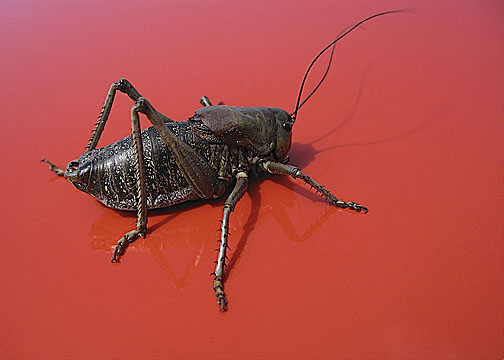Mormon Cricket (Anabrus simplex) - Wiki Mormon cricket
From Wikipedia, the free encyclopedia
[Photo] Mormon Cricket (Anabrus simplex) Male - Taken September 2005 Brian Head, UT
The so-called Mormon cricket (Anabrus simplex) is actually a shieldbacked katydid, and not a cricket at all. Mormon crickets are large insects that can grow to almost three inches in length. They live throughout western North America in rangelands dominated by sagebrush and forbs. The Mormon cricket is flightless, but capable of traveling up to two kilometers a day in its swarming phase, during which it is a serious agricultural pest and traffic hazard.
Appearance
Mormon crickets have variable coloration. The overall color may be black, brown, red, purple or green. The "shield" (actually vestigial wings) behind the head may have colored markings. The abdomen may appear to be striped. Females have a long ovipositor, which may be mistaken for a stinger. Both sexes have long antennae.
Mormon crickets may undergo morphological changes triggered by high population densities, similar to those seen in locusts. The best-attested change is coloration: solitary individuals typically have drab coloration while swarming individuals are often brightly colored.
Life cycle
Mormon cricket eggs mostly hatch the spring after they are laid, although in some high-elevation areas eggs may take two years to hatch. Hatching begins when soil temperatures reach 40 F (4 C). The nymphs pass through seven instars before reaching the adult stage, typically taking 60 to 90 days.
Breeding begins within 10 to 14 days of reaching the adult stage. The male passes a large spermatophore to the female, which can be up to 27% of his body weight. The spermatophore is mostly food for the female to consume but also contains sperm to fertilize her eggs. The value of this nuptial gift is such that swarming-phase females compete for males. This sexual role-reversal is not seen in solitary-phase females.
The female lays her eggs by thrusting her ovipositor deep into the soil. Females can lay about one hundred eggs each.
Swarming
The Mormon cricket exists in populations of relatively low density throughout most of its range. However, at certain times and places, population explosions or infestations occur in which large numbers of the cricket form roving bands. These bands may include millions of individuals and have a population density of up to 100 individuals per square meter. These infestations may last years or even decades, and are characterized by a gradual increase and then decrease in population. The factors that trigger these infestations are poorly understood, but are thought to be weather-related.
When a large band crosses a road it can cause a safety hazard by causing distracted revulsion on the part of the driver, and by causing the road surface to become slick with their fluids.
Food
The Mormon cricket prefers to eat forbs, especially cultivated crops such as alfalfa, and vegetables. Grasses and shrubs such as sagebrush are also eaten. Insects, notably other Mormon crickets, are also eaten, especially individuals that have been killed or injured by automobiles or insecticides. A recent study has suggested that the migration of swarms may be a strategy to avoid predation by other Mormon crickets.
During an infestation Mormon crickets can cause significant damage to crops and gardens, however they have not been shown to decrease the livestock forage value of rangeland.
Control
Mormon crickets are preyed upon by a wide variety of birds and mammals. These predators include California Gulls, crows, coyotes and various rodents. They were also eaten by Native Americans. There are no predators that specialize on Mormon crickets, which may be explained by the cricket's migratory habits and large population fluctuations.
The most common chemical control method used is carbaryl (typically sold as "Sevin") bait. This bait kills both the Mormon crickets that eat the bait, and the crickets that eat crickets that eat the bait. Insecticides applied directly to crops may kill the insects, but due to the large size of swarms this method usually does not save the crop from being destroyed.
As Mormon crickets are flightless, physical barriers may be effective. Barriers should be at least two feet high and made of a smooth material.
Historical influence
Tradition tells of a story where the first Mormon settlement in Utah was saved from famine by gulls eating hordes of Mormon crickets that had been destroying their first wheat crop; hence the name of the insect. California Gulls are known to relocate to desert areas to feed on Mormon cricket swarms, although their effectiveness in controlling infestations is thought to be minimal.
http://en.wikipedia.org/wiki/Mormon_cricket
| The text in this page is based on the copyrighted Wikipedia article shown in above URL. It is used under the GNU Free Documentation License. You may redistribute it, verbatim or modified, providing that you comply with the terms of the GFDL. |
